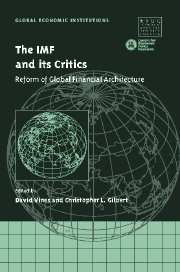Book contents
- Frontmatter
- Contents
- List of figures
- List of tables
- List of contributors
- Acknowledgements
- Introduction
- 1 The IMF and international financial architecture: solvency and liquidity
- 2 Progress towards greater international financial stability
- 3 International coordination of macroeconomic policies: still alive in the new millennium?
- 4 The Report of the International Financial Institution Advisory Commission: comments on the critics
- 5 Reforming the global financial architecture: just tinkering around the edges?
- 6 The IMF and capital account liberalisation
- 7 How should the IMF view capital controls?
- 8 The resolution of international financial crises: an alternative framework
- 9 Whose programme is it? Policy ownership and conditional lending
- 10 The IMF and East Asia: a changing regional financial architecture
- 11 The role of the IMF in developing countries
- 12 Argentina and the Fund: anatomy of a policy failure
- 13 Countries in payments' difficulties: what can the IMF do?
- 14 Accountability, governance and the reform of the IMF
- 15 The IMF at the start of the twenty-first century: what has been learned? On which values can we establish a humanised globalisation?
- Index
- References
6 - The IMF and capital account liberalisation
Published online by Cambridge University Press: 04 December 2009
- Frontmatter
- Contents
- List of figures
- List of tables
- List of contributors
- Acknowledgements
- Introduction
- 1 The IMF and international financial architecture: solvency and liquidity
- 2 Progress towards greater international financial stability
- 3 International coordination of macroeconomic policies: still alive in the new millennium?
- 4 The Report of the International Financial Institution Advisory Commission: comments on the critics
- 5 Reforming the global financial architecture: just tinkering around the edges?
- 6 The IMF and capital account liberalisation
- 7 How should the IMF view capital controls?
- 8 The resolution of international financial crises: an alternative framework
- 9 Whose programme is it? Policy ownership and conditional lending
- 10 The IMF and East Asia: a changing regional financial architecture
- 11 The role of the IMF in developing countries
- 12 Argentina and the Fund: anatomy of a policy failure
- 13 Countries in payments' difficulties: what can the IMF do?
- 14 Accountability, governance and the reform of the IMF
- 15 The IMF at the start of the twenty-first century: what has been learned? On which values can we establish a humanised globalisation?
- Index
- References
Summary
Introduction
In mid-1997, the IMF's Interim Committee issued a statement announcing that the time had come ‘to add a new chapter to the Bretton Woods agreement’. The statement called for the establishment of a ‘multilateral and non-discriminatory system to promote the liberalization of capital movements’. The Committee invited the Executive Board to complete work on a proposed amendment of the IMF's Articles that would make the ‘liberalization of capital movements one of the purposes of the IMF’ and extend the IMF's jurisdiction to enforce those obligations on its members.
The timing of this statement was not propitious. The massive reversal in capital flows to East Asia that followed the floating of the Thai baht on 2 July 1997, and which accelerated in the months after the IMF statement was issued, turned out to be unprecedented in its speed and scale. Although the crisis initially centred on the East Asian economies, the turbulence in emerging markets was much more widely felt. In June 1998, Russia was added to the critical list when its announcement of a debt moratorium prompted an unwinding of positions in Russian and other emerging markets. And in January 1999 the Brazilian government abandoned the peg on its exchange rate, a move which was prompted by rapid capital flight and which precipitated a large currency depreciation and further capital withdrawal. These crises prompted economists once again to take a harder look at the risks as well as the benefits of an open capital account.
- Type
- Chapter
- Information
- The IMF and its CriticsReform of Global Financial Architecture, pp. 156 - 180Publisher: Cambridge University PressPrint publication year: 2004



